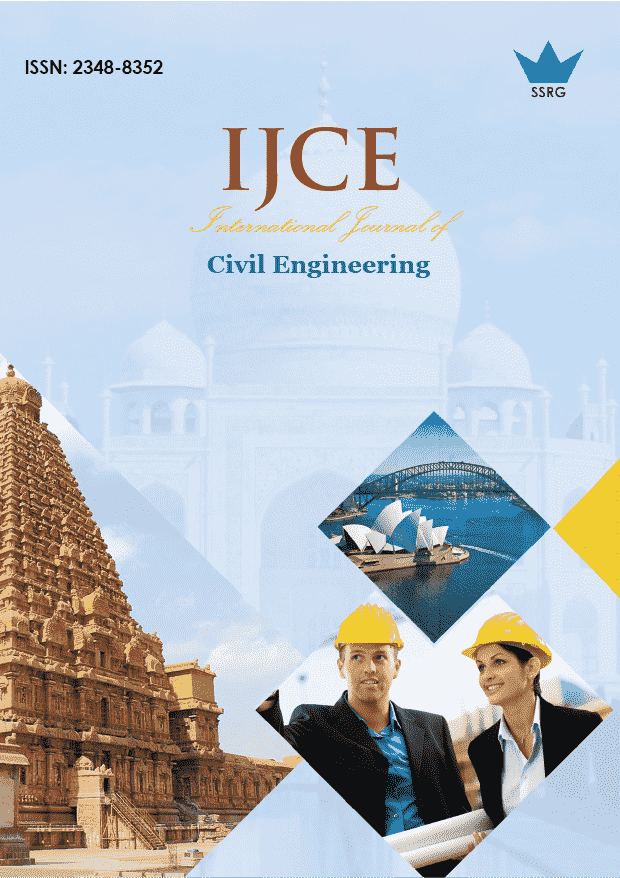Comparative Analysis of Steel Beam Fire Resistance Under Standard and Parametric Fire Scenarios

| International Journal of Civil Engineering |
| © 2025 by SSRG - IJCE Journal |
| Volume 12 Issue 10 |
| Year of Publication : 2025 |
| Authors : Riza Suwondo, Made Suangga, Religiana Hendarti |
How to Cite?
Riza Suwondo, Made Suangga, Religiana Hendarti, "Comparative Analysis of Steel Beam Fire Resistance Under Standard and Parametric Fire Scenarios," SSRG International Journal of Civil Engineering, vol. 12, no. 10, pp. 167-174, 2025. Crossref, https://doi.org/10.14445/23488352/IJCE-V12I10P113
Abstract:
Steel has a very good strength-to-weight ratio and flexibility, and therefore has a significant use in structural engineering. However, in high temperature situations, steel loses its strength and stiffness, which makes it very critical to consider in design. Conventional fire resistance evaluations use the standard ISO 834 fire. However, it does not consider compartment-specific elements such as compartment ventilation, the density of the fire load, and the thermal characteristics of the compartment boundaries. However, compartment fire ventilation, fire load density, and boundary thermal characteristics are incorporated into the Eurocode parametric fire model. This study, in consideration of both unprotected and passively protected conditions and standard and parametric fire scenarios, aimed to evaluate a supported steel beam’s fire performance. For the analysis, the author used a modified formulation for the protected case that considers the insulation and a simplified energy balance approach for unprotected steel. The fire performance rating is the time it takes for the steel temperature to reach the limiting temperature, which is determined by the applied load ratio. The steel temperature evolution for each configuration was predicted by calculating the gas temperature–time histories using the ISO 834 and Eurocode fire curves. The findings indicate that, even with its cooling phase, parametric fires require less time to reach the limiting temperature—the unprotected beam reached 670 °C in less than 8 minutes as opposed to the standard fire’s 14 minutes. By delaying the attainment of the critical temperature by roughly 24 minutes in a standard fire and 17 minutes in a parametric fire, passive fire protection significantly increased fire resistance. Because of its high peak temperature (~1050 °C) and quick heating rate, the parametric fire created more extreme thermal conditions in the early stages of exposure. The results show that, especially for unprotected members, parametric fires can pose a higher early-stage risk to steel structures than conventional fires. A more accurate evaluation of fire safety and more efficient specification of passive protection measures are made possible by integrating parametric fire scenarios into performance-based structural fire design.
Keywords:
Steel Beam, Fire Resistance Rating, Standard Fire, Parametric Fire, Passive Fire Protection.
References:
[1] Andrea Lucherini, and Cristian Maluk, “Intumescent Coatings Used for the Fire-Safe Design of Steel Structures: A Review,” Journal of Constructional Steel Research, vol. 162, pp. 1-29, 2019.
[CrossRef] [Google Scholar] [Publisher Link]
[2] Yifan Cao et al., “Progressive Collapse of Steel Structures Exposed to Fire: A Critical Review,” Journal of Constructional Steel Research, vol. 207, 2023.
[CrossRef] [Google Scholar] [Publisher Link]
[3] Shiyun Pang et al., “Fire Resistance of Steel Structures, Incorporating HSS - Review and Recommendations,” Journal of Constructional Steel Research, vol. 217, 2024.
[CrossRef] [Google Scholar] [Publisher Link]
[4] Gian-Luca F. Porcari, Ehab Zalok, and Waleed Mekky, “Fire Induced Progressive Collapse of Steel Building Structures: A Review of the Mechanisms,” Engineering Structures, vol. 82, pp. 261-267, 2015.
[CrossRef] [Google Scholar] [Publisher Link]
[5] Guobiao Lou et al., “Experimental and Numerical Study on Thermal-Structural Behavior of Steel Portal Frames in Real Fires,” Fire Safety Journal, vol. 98, pp. 48-62, 2018.
[CrossRef] [Google Scholar] [Publisher Link]
[6] Guo-Qiang Li et al., “Experimental and Numerical Study on Collapse Modes of Single Span Steel Portal Frames Under Fire,” Engineering Structures, vol. 245, 2021.
[CrossRef] [Google Scholar] [Publisher Link]
[7] Guobiao Lou et al., “Fire Tests on Full-Scale Steel Portal Frames against Progressive Collapse,” Journal of Constructional Steel Research, vol. 145, pp. 137-152, 2018.
[CrossRef] [Google Scholar] [Publisher Link]
[8] C.V. Manoj Kumara et al., “The Collapse Mechanism of Steel Framed Structure Exposed to Parametric Design Fire and Travelling Fire Scenarios,” Materials Today: Proceedings, 2023.
[CrossRef] [Google Scholar] [Publisher Link]
[9] R. Sridhar, and H.C. Guruprasad, “Nonlinear Analysis of Multi-Storied Steel Framed Structure under Fire Loads,” Materials Today: Proceedings, 2023.
[CrossRef] [Google Scholar] [Publisher Link]
[10] Yiwen Wu et al., “Scale Test of Large Space Stainless Steel Structure Subjected to Natural Fire,” Journal of Constructional Steel Research, vol. 210, 2023.
[CrossRef] [Google Scholar] [Publisher Link]
[11] ISO 834-2:2019 Fire-Resistance Tests — Elements of Building Construction Part 2: Requirements and Recommendations for Measuring Furnace Exposure on Test Samples, 1st ed., International Organization for Standardization, pp. 1-14, 2019.
[Publisher Link]
[12] ASTM E119-19 Standard Test Methods for Fire Tests of Building Construction and Materials, ASTM Standard Book, pp. 1-37, 2020.
[Publisher Link]
[13] Eurocode 1: Actions on Structures—Part 1-2: General actions—Actions on Structures Exposed to Fire, European Committee for Standardization, 2002.
[Google Scholar] [Publisher Link]
[14] Jethro David Howard, Ignacio Paya-Zaforteza, and Guillem Peris-Sayol, “Parametric Fire Curves for I-Girder Bridges Submitted to Under Deck Tanker Fires,” Engineering Structures, vol. 306, pp. 1-16, 2024.
[CrossRef] [Google Scholar] [Publisher Link]
[15] J. Zehfuss, and D. Hosser, “A Parametric Natural Fire Model for the Structural Fire Design of Multi-Storey Buildings,” Fire Safety Journal, vol. 42, no. 2, pp. 115-126, 2007.
[CrossRef] [Google Scholar] [Publisher Link]
[16] Florian Put et al., “Model Uncertainty in a Parametric Fire Curve Approach: A Stochastic Correction Factor for the Compartment Fire Load Density,” Fire Safety Journal, vol. 144, 2024.
[CrossRef] [Google Scholar] [Publisher Link]
[17] Wei-Yong Wang, Guo-Qiang Li, and Venkatesh Kodur, “Approach for Modeling Fire Insulation Damage in Steel Columns,” Journal of Structural Engineering, vol. 139, no. 4, pp. 491-503, 2012.
[CrossRef] [Google Scholar] [Publisher Link]
[18] Beril Oğuz et al., “Evaluating the Impact of Testing Conditions on Intumescent Coatings' Fire Performance: A Comparison of Laboratory-Scale and Industrial-Scale Experiments,” Fire Safety Journal, vol. 153, pp. 1-14, 2025.
[CrossRef] [Google Scholar] [Publisher Link]
[19] Kun Meng et al., “Post-Fire Behaviour of Prefabricated Cruciform Fireproof Board and Thin Concrete Encased Steel Columns: Test, Simulation and Machine Learning-based Modelling,” Journal of Building Engineering, vol. 108, 2025.
[CrossRef] [Google Scholar] [Publisher Link]
[20] Qian Zhang, and Victor C. Li, “Ductile Cement-Based Spray-Applied Fire-Resistive Materials,” Journal of Structural Fire Engineering, vol. 7, no. 2, pp. 114-125, 2016.
[CrossRef] [Google Scholar] [Publisher Link]
[21] Venkatesh Kodur, and Amir Arablouei, “Effective Properties of Spray-Applied Fire-Resistive Material for Resistance to Cracking and Delamination from Steel Structures,” Construction and Building Materials, vol. 84, pp. 367-376, 2015.
[CrossRef] [Google Scholar] [Publisher Link]
[22] Ilias Thanasoulas et al., “The Finite Element Method for Evaluating the Fire Behavior of Steel Structures,” Journal of Structural Fire Engineering, vol. 14, no. 2, pp. 185-201, 2023.
[CrossRef] [Google Scholar] [Publisher Link]
[23] Min Gyu Ryu et al., “Finite Element Modeling for the Progressive Collapse Analysis of Steel Stiffened-Plate Structures in Fires,” Thin-Walled Structures, vol. 159, pp. 1-26, 2021.
[CrossRef] [Google Scholar] [Publisher Link]
[24] Anthony P. Hamins et al., “Experiments and Modeling of Unprotected Structural Steel Elements Exposed to a Fire,” Proceedings Eighth (8th) International Symposium: International Association for Fire Safety Science (IAFSS), Beijing, pp. 189-200, 2005.
[Google Scholar] [Publisher Link]
[25] Igor Džolev, Sofija Kekez-Baran, and Andrija Rašeta “Fire Resistance of Steel Beams with Intumescent Coating Exposed to Fire Using ANSYS and Machine Learning,” Buildings, vol. 15, no. 13, pp. 1-19, 2025.
[CrossRef] [Google Scholar] [Publisher Link]
[26] Alexandre Magnus Jordão et al., “Experimental Analysis of Fire-Resistant and Non-Fire-Resistant Steel Beams,” Fire Safety Journal, vol. 138, 2023.
[CrossRef] [Google Scholar] [Publisher Link]
[27] Weihua Wang et al., “Fire Test on Insulated Steel Beams with Fire-Protection Coating and Fiber Cement Board,” Buildings, vol. 15, no. 12, pp. 1-23, 2025.
[CrossRef] [Google Scholar] [Publisher Link]
[28] Design Manual on the European Recommendations for the Fire Safety of Steel Structures, 1st ed., European Commission for Constructional Steelwork, pp. 1-202, 1985.
[Publisher Link]

 10.14445/23488352/IJCE-V12I10P113
10.14445/23488352/IJCE-V12I10P113